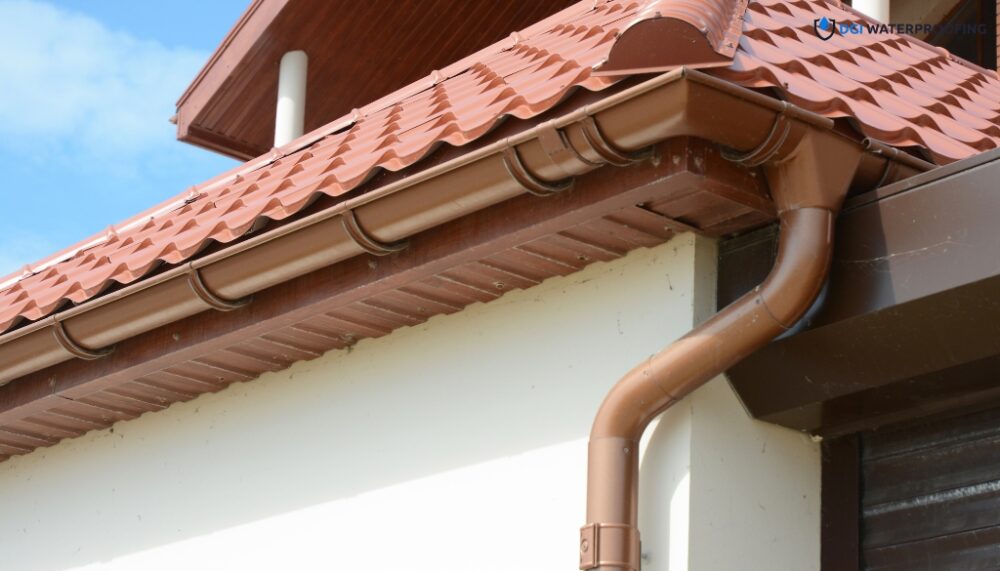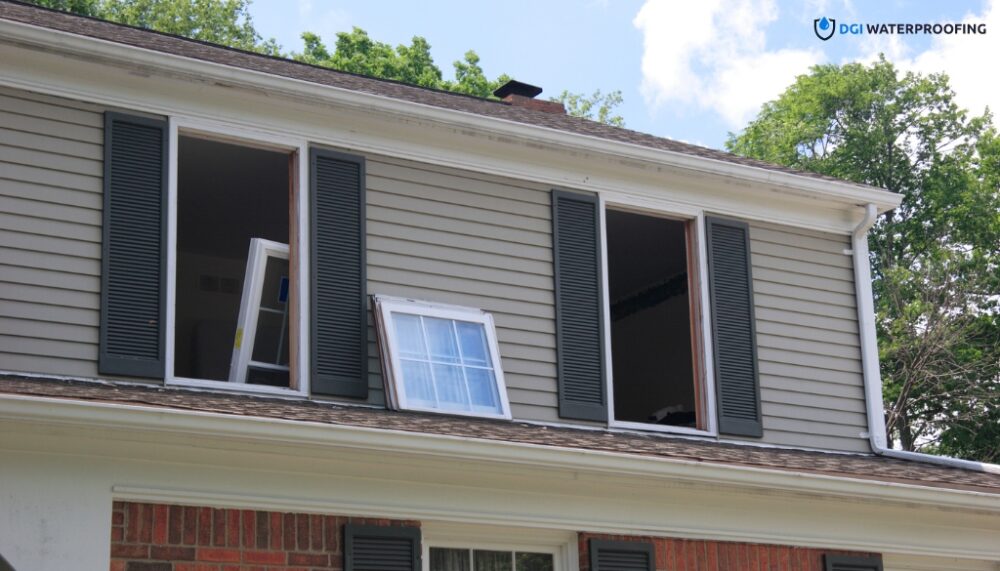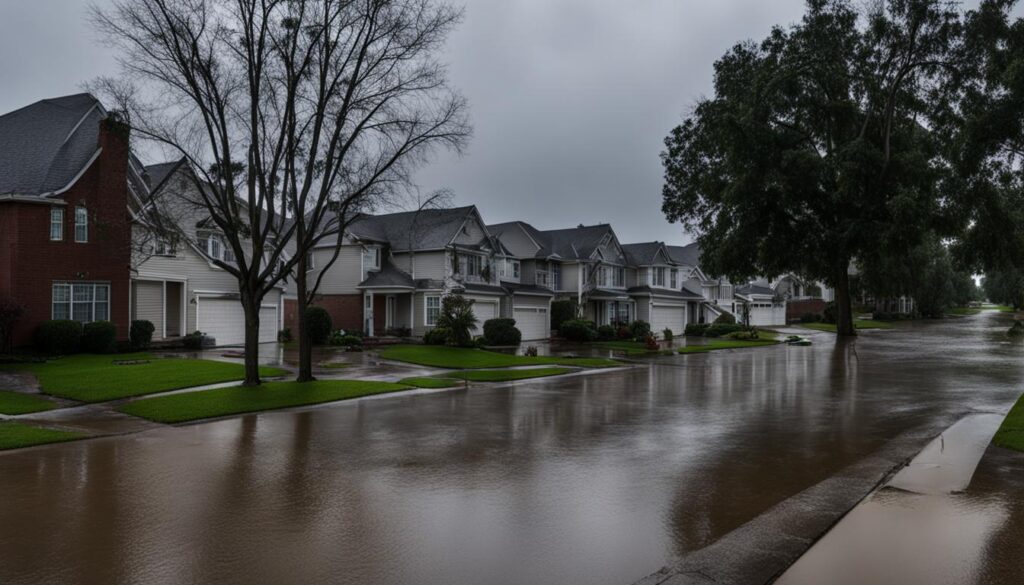Welcome to our essential guide on how to prepare your home for a big rainstorm. With the unpredictable weather patterns we’ve been experiencing lately, it’s important to be prepared for whatever mother nature throws our way. From rainstorm preparedness to home preparation tips, we’ve got you covered. By following the steps outlined in this guide, you’ll be able to keep your property and belongings safe during adverse weather conditions.
Key Takeaways:
- Preparing your home for a big rainstorm is crucial to minimize property damage and keep your belongings safe during adverse weather conditions.
- Understanding the potential risks of heavy rain is an important first step in protecting your home.
- Regular inspection and maintenance of your gutters and downspouts will ensure that they are free from debris and able to effectively drain water away from your home.
- Properly weatherproofing your doors and windows is essential in preventing water leaks and infiltration during a rainstorm.
- Protecting your basement from water damage is a key consideration when preparing your home for a big rainstorm.
Understanding the Risks of Heavy Rain
Protecting your home from heavy rain requires taking appropriate steps to safeguard your property from potential damage and costly repairs. During heavy rain, water can seep into your home through even the smallest vulnerabilities, causing severe flooding, structural damage, and other hazards. Here are some steps to safeguard your home during a rainstorm:
Identify Potential Risks
Before a rainstorm hits, take a moment to identify any potential risks around your home. Check areas that have previously experienced water damage, such as your basement or crawl space, and take measures to prevent water from entering these areas. If your home is located in a flood-prone area, consider installing flood gates or barriers to protect against rising water levels.
Inspect Your Roof
One of the most vulnerable areas of your home during heavy rain is the roof. Check for any loose or missing shingles, cracks or leaks, and get them repaired before the storm hits. Do not neglect cleaning your gutters before the rain starts because clogged gutters can cause water damage to your roof and home.
Seal Windows and Doors
To prevent water from seeping into your home, make sure your windows and doors are properly sealed. Check for any cracks or gaps and seal them with caulk or weatherstripping. If you have a basement, install a sump pump to help drain any water that may enter.
Landscaping for Rainstorms
Proper landscaping can also help protect your home from heavy rain. Ensure your yard and other outdoor areas have proper drainage and grading to prevent water from pooling near your home’s foundation. Trim any trees or branches that may pose a risk of falling during the storm. Also, consider installing a rain garden, which can help manage excess water during a heavy rainstorm.
Conclusion
By taking these steps, you can minimize the risk of damage to your home during a heavy rainstorm. Remember to always prioritize the safety of you and your family during severe weather conditions.
Inspecting and Maintaining Gutters and Downspouts
If you want to prepare your home for a big rainstorm, checking and maintaining gutters and downspouts should be high on your rainstorm readiness checklist.
Gutters and downspouts are designed to direct water away from your home, but if they are blocked, damaged or not functioning properly, they can cause water to overflow and seep into your home, causing extensive damage and costly repairs.

What to Look for When Inspecting Gutters and Downspouts
Regularly inspecting your gutters and downspouts can help you detect and fix any issues before they lead to serious damage. Here’s what you should look for:
- Debris: Clear out leaves, twigs, and other debris that can accumulate in gutters and downspouts. A clogged gutter can cause water to back up and spill over, damaging your roof and walls.
- Cracks and Holes: Check for any visible damage to gutters and downspouts, such as cracks, holes, and rust spots. These can cause leaks and allow water to seep into your home.
- Sagging: If your gutters are sagging, it’s a sign that they are not properly attached and need to be re-secured. This can prevent water from flowing towards the downspout and direct it towards your home instead.
How to Maintain Gutters and Downspouts
Maintaining your gutters and downspouts is relatively simple and can save you a lot of trouble down the road. Here’s what you can do:
- Clean Them Out: Clear out debris from gutters and downspouts at least twice a year, or more often if you live in an area with a lot of trees. You can use a hose, a brush or a special tool to remove dirt and leaves.
- Repair Damage: Patch up any visible damage with sealant or replace damaged sections entirely if needed. You can also add gutter guards to make cleaning and maintenance easier and prevent future blockage.
- Check for Proper Drainage: Ensure that water flows smoothly through gutters and downspouts and away from your home. If there are any issues, you might need to redirect downspouts or trim trees that are blocking them.
By following these simple steps, you can ensure that your gutters and downspouts are in good shape and ready to handle heavy rainfall. Remember to add gutter and downspout maintenance to your preparing for a rainstorm at home checklist!
Weatherproofing Doors and Windows
Heavy rain can quickly become a problem when it finds its way into your home through leaks in windows and doors. To secure your house for a big rainstorm, it’s important to take the necessary steps to weatherproof your home. Here are some tips for weatherproofing your doors and windows:
Filling in Gaps
Check for any gaps or cracks in your windows and doors, both inside and outside your home. Use caulk to fill in any gaps around your window frames and door frames to prevent water from seeping in. You can also add weather-stripping to the bottom of your doors to keep water out.
Install Shutters
Install shutters on the outside of your windows to protect them from wind-blown rain. Shutters also serve as an extra layer of protection against debris that may fly around during a storm. Wooden shutters are the most secure, but metal and plastic shutters can also provide adequate protection.
Replace Damaged Windows and Doors
If your windows and doors are old or damaged, they may not withstand heavy rain and wind. Consider replacing them with newer, hurricane-rated models to ensure they are secure during adverse weather conditions. Be sure to hire a professional to ensure proper installation.

By following these tips for securing your house for a big rainstorm and weatherproofing your home, you can protect yourself and your property from the adverse effects of heavy rain.
Protecting Your Basement from Water Damage
Basements are particularly vulnerable to water damage during heavy rainstorms. It is crucial to take necessary precautions to safeguard your property and belongings from potential water damage. Here are some tips on how to protect your basement:
Check Your Sump Pump
A sump pump is a critical tool that helps prevent basement flooding. Ensure that your sump pump is in good working condition by performing regular maintenance. Consider installing a battery backup sump pump in case of power outages.
Inspect Your Foundation
Cracks in your foundation can allow water to seep into your basement. Regularly inspect your foundation, and if you find any cracks, seal them immediately to prevent water infiltration.
Check Your Windows and Doors
Windows and doors in your basement can also be potential entry points for rainwater. Ensure that all windows and doors are properly sealed to prevent water from seeping in. Consider adding weatherstripping or caulking around the frames for additional protection.
Clean Your Gutters and Downspouts
Clean gutters and downspouts can prevent rainwater from overflowing and entering your basement. Ensure that your gutters and downspouts are free from debris and able to effectively drain water away from your home.
Install Flood Sensors
Flood sensors are an essential tool in detecting water leaks and potential flooding in your basement. Consider installing flood sensors and connecting them to a monitoring service that alerts you in case of any water infiltration.
By following these tips and including them in your rainstorm readiness checklist, you can protect your basement from water damage and ensure the safety of your property and belongings.
Securing Outdoor Items and Landscaping
When preparing your home for a rainstorm, it’s important not to forget about your outdoor items and landscaping. Here are some rainstorm home preparation tips to ensure your outdoor spaces are safe:
Securing Outdoor Furniture
One of the first things you should do is secure your outdoor furniture. Move lightweight items, such as chairs and small tables, indoors to avoid them from being carried away by heavy rain or winds. For heavier furniture, use ropes or chains to anchor them in place.
Trimming Trees
Trimming trees and removing any dead limbs is an essential step in preparing for a rainstorm. This will prevent limbs from breaking off and causing damage to your home, vehicle or outdoor structures.
| Tree Type | Recommended Trimming Schedule |
|---|---|
| Conifers (Pine, Spruce, etc.) | Trimmed in late winter or early spring |
| Deciduous (Maple, Oak, etc.) | Trimmed in the fall after leaves have fallen |
Protecting Your Garden
Your garden is also vulnerable to heavy rain. Here are some rainstorm preparedness tips to protect your garden:
- Remove any dead plants or debris from your garden to prevent clogs in drains or gutters.
- Consider adding sandbags around your garden or in low areas to prevent flooding.
- Use a tarp or other covering to protect delicate plants from heavy rain and wind.
Emergency Preparedness and Safety Measures
When preparing for a big rainstorm, it’s important to not only focus on your home but also on emergency preparedness and safety measures. Follow these essential tips to ensure you and your family are safe during adverse weather conditions.
Stay Informed
Keep up-to-date with the latest weather forecasts from reliable sources. Sign up for weather alerts through your local news station or use a weather app to keep track of changing conditions. This information will help you make informed decisions about when to take necessary precautions.
Have an Emergency Kit Ready
Prepare an emergency kit ahead of time, so you have everything you need in case of a power outage or evacuation. Include items like non-perishable food, water, a first-aid kit, flashlights, and extra batteries. Make sure everyone in your household knows where the emergency kit is located.
Create a Family Emergency Plan
Develop a family emergency plan and communicate it with everyone in your household. The plan should include an evacuation route, a meeting place in case of separation, and a way to communicate with each other in case of lost power or cell service.
Turn Off Electricity and Gas
If advised to evacuate or if you are experiencing flooding, turn off your electricity and gas to prevent accidents and fires. Only turn them back on once it’s confirmed safe to do so.
Stay Indoors and Away from Windows
During a rainstorm, stay indoors and away from windows. Heavy winds and rain can cause trees and debris to fall, which can be dangerous if you’re too close.
Be Careful when Driving
If you must drive during a rainstorm, proceed with caution. Avoid driving through flooded areas and keep a safe distance from other vehicles. If your car starts to hydroplane, take your foot off the gas and steer in the direction you want to go.
By following these emergency preparedness and safety measures, you can ensure the safety of you and your family during a big rainstorm. Don’t forget to also prepare your home by following the previous tips for rainstorm home preparation.
